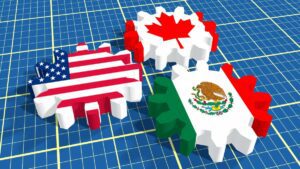|
International trade has gotten a bum rap in recent years, despite accounting for 25 percent of U.S. economic activity and its significant contribution to raising productivity and real incomes. Middle-class Americans gain about a quarter of their purchasing power from trade, while nearly half of imports are inputs for U.S. businesses. Exporting firms also pay higher wages, and the United States is the global champion in services exports.
Nonetheless, former President Donald Trump tapped into a growing popular resentment of trade and has continued with his hallmark assertion “that foreign countries… have been ripping us off for years” and they “come in and take advantage of our country.” The Joe Biden administration has continued in the same vein, claiming that trade has “contributed to the hollowing out of the American industrial base and vital U.S. jobs, and harmed many of our communities and working families, undermining support for democracy itself.” With such portrayals, it is hard to see how anyone would favor trade.
In a speech at the Brookings Institution in April 2023, National Security Advisor Jake Sullivan cited trade liberalization—together with markets allocating capital efficiently and productively and the notion that all growth is good growth—as assumptions whose limits were laid bare by the “the shocks of a global financial crisis and a global pandemic.” He proclaimed that a new consensus is needed to “build a fairer, more durable global economic order, for the benefit of ourselves and for people everywhere.”
Smart industrial policy to advance national security, address climate change, and promote innovation can have its place. But it is a mistake to give short shrift to markets, trade, and growth, as they are the very mechanisms that raise incomes, a necessary part of addressing the unfairness issues cited by the last two administrations. Two phenomena are at play: a misperception and a misplaced perception.
Misperception
The misperception is the apparent view of Biden administration officials that the usual levers of fiscal and monetary policy were not working properly. During the Great Recession, the prime age employment-population ratio—which tracks the proportion of all Americans between the ages of twenty-five and fifty-four who are employed—tumbled from 80 percent in January 2008 to 75 percent by October 2009 and took nearly a decade to recover. Journalist Matthew Yglesias has suggested than rather than admit the Barack Obama administration stimulus measures were inadequate, the notion took hold that the sluggish labor-market recovery was due to something more “profound and conceptual.” Perhaps this is why officials rolled out a “worker-oriented trade policy” that has maintained the Trump administration’s tariffs, eschewed new market-opening arrangements, promoted onshore production, and expanded Buy American provisions.
But, in fact, the economic machinery of the United States works fine. As the COVID-19 pandemic dropped the prime age employment-population ratio down to 70 percent, the Biden administration’s massive stimulus package and a forward-looking Federal Reserve headed off another slow labor-market recovery. The prime age employment-population ratio popped back up to 80 percent within two years, faster than forecast. Whatever merits the worker-oriented trade measures could have had to create jobs, they are not appropriate in a relatively tight labor market with unemployment at 4.2 percent.
Misplaced Perception
The misplaced perception is that trade has few benefits when they are overwhelmed by other unfavorable economic conditions. Intuitively this makes sense. When Walmart shoppers’ savings on purchases of a tradable items—produced abroad or in the United States—are more than eaten up by rising rent and medical costs, awareness of any benefits from trade quickly evaporates like water on a hot rock.
This dynamic was evident during the Great Recession. Those who believed trade was good for the country collapsed from 78 percent to 58 percent and never fully recovered. When the pandemic undercut the economy, the 79 percent who thought foreign trade presented an opportunity for growth in 2020 slipped to 61 percent, according to a Gallup poll.
Even though more recent headline data suggest that the economy is doing well, a May 2024 Pew survey reported that only 23 percent of respondents believed that economic conditions in the country were excellent or good. It is no wonder that 59 percent of respondents believe that the United States has lost more than it has gained from increased trade with other nations, a 3 percent increase from 2021.
|






